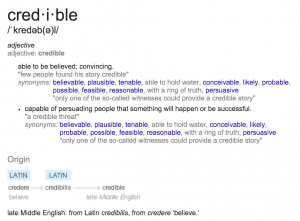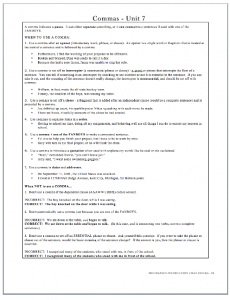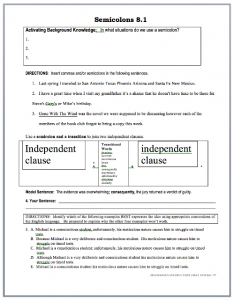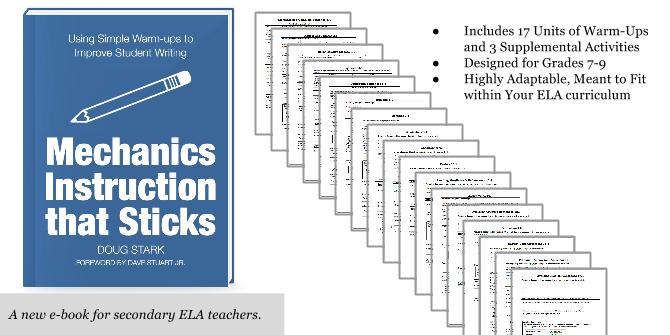At the time of this writing, Doug Stark's Mechanics Instruction that Sticks: Using Simple Warm-Ups to Improve Student Writing has been purchased by half a thousand people; these educators come from seven different countries and 48 US states. (New Mexico and Delaware, if you're wondering.) Needless to say, Doug and I are humbled and happy that the book seems to be meeting a need.
In my reading of late, I've been making connections to Doug's book of warm-ups. Two books in particular have been insightful: John Hattie's Visible Learning and Peter Brown, Henry Roediger, and Mark McDaniels' Make It Stick. Specifically, Hattie's meta-analysis has reminded me of things that no curriculum or resource can ever do, and Brown, Roediger, and McDaniels' work has shown me why Doug's warm-ups tend to help kids improve the mechanics of their writing.
What no curriculum or resource can do
I think it's helpful to start with why Mechanics Instruction that Sticks certainly isn't a silver bullet. You won't make a bunch of photocopies of the first unit of warm-ups, hand them out, and then magically see students write more mechanically sound sentences. First of all, such a “chuck worksheets at kids” approach is completely contrary to the instructional flow Doug lays out in the introduction (read that introduction free right here). But furthermore, no curriculum or resource, in the hands of a teacher without credibility, isn't going to magically work wonders.

The importance, and the un-buy-ability, of teacher credibility
In Visible Learning for Teachers, John Hattie shares that, of all the influences on student achievement examined in his meta-analysis, the fourth highest influence (at an effect size of .90), is teacher credibility.
Basically, if students don't perceive you as a person who can make a difference in their lives — if they don't believe in you (see Figure 1) — then they, in Hattie's words, “just turn off.” [1]
Hattie breaks teacher credibility down into four parts: trust, competence, dynamism, and immediacy.
- Trust: Doug's warm-ups can't make you consistent and fair. When students share their sentences, are you fair in calling on them? Are you consistent with ensuring that students are doing the work?
- Competence: A solid curricula or resource might make us appear more competent to our students (e.g., Doug's warm-ups give teachers a coherent, focused approach to teaching and applying English sentence knowledge), but there's no replacing the work it takes to study up on mechanics and understand what you're teaching to the point where you can explain it a few different ways. Mechanics Instruction that Sticks does give summary sheets for each unit's topic and provide an excellent, comprehensive introduction (read it free here), but it pairs beautifully with additional reading (try Grammar Girl).
- Dynamism: No curricula can make you a better, more energized deliverer of instruction.
- Immediacy: Doug's warm-ups won't help you make eye contact with students.
These four components, according to Hattie, combine to become teacher credibility. This, of course, isn't something you can buy; you develop it over the course of a career through consistent, focused effort. It is the eventual fruit of operating with an Inner Scorecard.
What Mechanics Instruction that Sticks does do

I started reading Brown, Roediger, and McDaniels’ Make It Stick after Doug's book came out, and I don't think Doug has read it yet. However, it certainly does explain why students who came to me from Doug years ago tended to be much sounder writers than students Doug received from me. Essentially, Doug's warm-ups provide a simple, condensed application of several concepts in Make It Stick, and as a result Doug's kids tended to retain language knowledge in ways mine didn't.
Foundational knowledge
As Brown, Roediger, and McDaniels put it, “All new learning requires a foundation of prior knowledge.” Too often, I think we English teachers fall into the trap of approaching grammar and mechanics knowledge with hesitancy. The wisdom of the day suggests that it's best to teach kids the mechanics knowledge they need only right when they need it, delivering mechanics instruction solely within one-on-one or small group settings. This, in Doug's and my opinion, is needlessly reductionistic. Why shouldn't knowledge of the English language be part of a guaranteed, viable curriculum?
It is important, of course, not to allow mechanics instruction to stretch from 5-10 minutes at the start of class to 30-40 minute lessons. This, indeed, would become tiresome for students who've largely “got it” and need to move on. Efficiency is one of Doug's chief concerns for this very reason.
With these things said, Doug's book delivers a coherent sequence of foundational language knowledge, and each unit of warm-ups is introduced with an Explanatory Page (see Figure 2).
Retrieval practice
Yet for knowledge to “stick,” spaced retrieval practice is necessary.
From Make It Stick:
While the brain is not a muscle that gets stronger with exercise, the neural pathways that make up a body of learning do get stronger, when the memory is retrieved and the learning is practiced. Periodic practice arrests forgetting, strengthens retrieval routes, and is essential for hanging onto the knowledge you want to gain.

On Doug's warm-ups (see Figure 3), there's an “Activating Background Knowledge” section that allows for this to take place.
Interleaved and varied practice
To further enhance knowledge retention, it is useful to mix up how that knowledge is used.
From Make It Stick:
When you're adept at extracting the underlying principles or “rules” that differentiate types of problems, you're more successful at picking the right solutions in unfamiliar situations. This skill is better acquired through interleaved and varied practice than massed practice. For instance, interleaving practice at computing the volumes of different kinds of geometric solids makes you more skilled at picking the right solution when a later test presents a random solid. Interleaving the identification of bird types or the works of oil painters improves your ability both to learn the unifying attributes within a type and to differentiate between types, improving your skill at categorizing new specimens you encounter later.
Doug's warm-ups work at this in two ways. First, they ask students to practice a given unit's knowledge through sentence corrections, sentence creations, and ACT/SAT-style multiple choice questions. (Please leave any “all things multiple choice are evil” dogmas at the door; see Figure 3). Second, as already mentioned, Doug's warm-ups are intentionally concise — this isn't “massed practice.”[hr]
Even if you're not an English teacher using these warm-ups, I hope that some of the above principles have helped.
What people are saying about Mechanics Instruction that Sticks
 Finally, it's worth sharing not just my own thoughts on Doug's book of warm-ups. Here's what others have said:
Finally, it's worth sharing not just my own thoughts on Doug's book of warm-ups. Here's what others have said:
- “I feel that [these warm-ups are] really helping my students understand! I haven't had success with the mechanics of grammar before.”
- “Our whole department has been using [these warm-ups] for the past nine weeks, and I think it is the perfect amount of time on each [unit]!”
- “This is a great, no fuss resource. My students are used to the routine of completing these as soon as they come into class, and are taking a great deal from the work.”
- “I love the ability to do it quickly a few days a week but also that I can get multiple kids involved in a short time period.”
- “I love the quick hit on grammar every day. The repetition is working great to help the kids remember the concepts, and the topics are just right.”
- “The warm-up is quite direct. It constantly builds on previous lessons. My adult education students who are studying for their GEDs love this approach and they edit their own writing with more confidence. Confidence is always an issue in our writing classes. This simple tool has helped my students demonstrate that they are aware of how sentences are or can be assembled. Thanks so much for sharing this with us. By the way I constantly sing the praises of this product so there should be some orders coming your way.”
- “I struggle with integrating all the various grammar concepts into my daily lessons. This resource enables me to address grammar concepts clearly and simply in my daily lessons. The students are responding well and seem to understand the “whys” of grammar and how it connects to communication in writing. Thank you so much for making this excellent tool available.”
- “I've been really happy with this product. It has been helpful that I can focus on setting up a common vocabulary about this aspect of the curriculum with students and is flexible enough that I can pick and choose the aspects the class needs.”
- “It's ready made. Consistent and repetitive. What kids needs to stay fresh with grammar.”
If you'd like to read an introduction to the book, click here. If you'd like to purchase Mechanics Instruction that Sticks ($10), click here.
Footnote:
- From an interview by Darren Evans for TES, titled “Make Them Believe In You.”
Leave a Reply